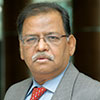India’s capacity to deal with a disaster depends on government investment into IT infrastructure
Different types of natural disasters – like flood, drought, earthquake, cyclone, hurricane, tsunami and landslide – strike different corners of the world depending on their vulnerability in terms of geological, geographical and climatic factors. The aboriginals treated disasters as curses by god and, therefore, worshipped and propitiated fire, water and wind to be spared of their fury and wrath. With the advent of technology, however, different governments have been able to significantly reduce the damage due to disasters. Considerable emphasis is now being placed on research and development activities in the areas of information and communication technology (ICT) for disaster management.
Quintessentially, natural disasters cause damage and result in disruption of ICT infrastructure, which is necessary for effective and efficient disaster management activities. Communication systems like radio, television, telephones (fixed and mobile), SMS and voice mail have a role to play in disaster mitigation. Cell broadcasting is one of the major resources in managing disasters by sending text messages to the screens of all mobile devices which have such a capability in any group of cell of any size, ranging from single cell to the whole country, if necessary.
It requires a state-of-the-art IT infrastructure along with highly optimised standard operating procedures to arrive at the best utilisation of IT solutions. A case in point is the proposal of putting a state-wide modern ICT network for emergency response by the Gujarat disaster management authority. The SEOC is envisaged to have communication facilities with six levels of redundancy for communicating with all stakeholders during the time of an emergency or a disaster. This network would be designed for integrating the SEOC at Gandhinagar with 26 district emergency operation centres, five emergency response centres and 226 taluka emergency operation centres.
The state administration will establish a secure centralised location with adequate communication for planning, decision support and coordination during a disaster or emergency. Internet, GIS, remote sensing, satellite-based communication links can help in planning and implementation of disaster risk reduction measures. These technologies have been playing a major role in designing early warning systems, catalyzing the process of preparedness, response and mitigation. GIS-based systems improve the quality of analysis of hazard vulnerability and capacity assessment guide development planning and assist planners in the selection of mitigation process.
Satellite radio and technology applications like remote sensing satellites (earth observations), weather monitoring, early warning systems (satellite-activated audio-visual warning alarm beacon and buoys, GPS navigation satellite (co-ordinate observation and location), satellite broadcasting, etc,. serve as facilitating technologies in addressing these needs. All these technologies provide position information for mapping where no mapping information is available. In fact, incorporation of GPS in mobile phones places an emergency location capability in the hands of everyday user. Multiple data centres and wide area networks of different states and government departments have to be part of a larger single government cloud if the disaster mitigation efforts have to percolate to the last formation at the village level. This would require national spatial data infrastructure to be accorded a legal status with clear mandate of a designated department of the Indian government to own all data in the public domain.
